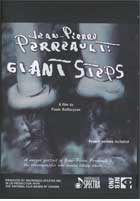
Jean-Pierre Perreault: Giant Steps 2006
Distributed by National Film Board of Canada, 1123 Broadway, Suite 307, New York, NY 10010; 800-542-2164
Produced by Amérimage Spectra (Lisa Cochrane) and the National Film Board of Canada (Yves Bisaillon)
Directed by Paule Baillargeon
DVD, color, 53 min.
Jr. High - Adult
Dance
Date Entered: 10/27/2006
Reviewed by Janis Tyhurst, Reference Librarian, George Fox UniversityFilmed in the days leading up to the death of Jean-Pierre Perreault, this documentary explores the life, work and influences on one of Canada’s premier modern choreographers.
The DVD has chapters for each element of his life, from the early days to his final hours. Each chapter focuses on a particular element, his early life and its influence on his later works, his travels abroad, his vision of dancing—what it was and what it should be, the role of the dancer. These thoughts are brought out in an interview format. Interviews with others who worked with Jean-Pierre are also included. Paralleling the interview with Jean-Pierre is a dancer representing him dancing out the interview element.
Jean-Pierre’s early family life was difficult and marked him profoundly. At 14, he was reading Sartre and Kafka, and their dark view of humanity further influenced his view of the world. At 17, he found Jeanne Renaud and her dance company, Le Groupe de la Place Royale. It is in this sphere he found at last a family where he could belong. In those heady days, he heard the views of painters, dancers, set designers—the avant-guard of Montreal, as they gathered at Jeanne Renaud’s home to share, create and debate life.
Woven in each section are photos of Jean-Pierre and film clips of his choreographed works. An early piece (“For 16 women and a dozen cows/Les Dames aux vaches”) is a humorous dance of 16 women in a pasture with 12 cows. His later works are darker pieces about the alienation of a person within humanity, the loss of love or its darker aspects. Jean-Pierre transformed the dance scene with his work entitled “Joe,” that premiered in 1983 at the University of Québec at Montreal. This work included 32 dancers—an enormous troop by dance company standards. Jean-Pierre used the rhythm of footsteps to attain the dramatic potential, evoking the primal human need in each person to be part of something greater or feeling the loss of not belonging.
This documentary will be of interest to anyone involved in modern dance or dance history. It provides an excellent retrospective view of the development of his choreography and insight into his creative processes. The film quality and sound is good. There is a French language option that is also the same high quality as the English version.